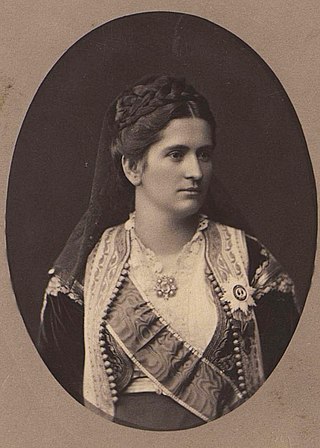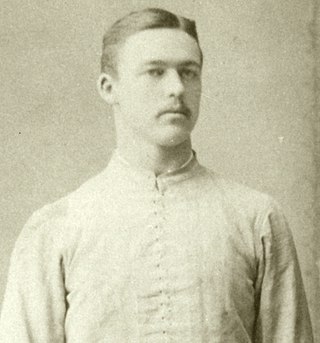
Emilie Charlotte, Lady de Bathe, known as LillieLangtry and nicknamed "The Jersey Lily", was a British socialite, stage actress and producer.

Pontiac is a city in and the county seat of Oakland County in the U.S. state of Michigan. As of the 2020 census, the city had a total population of 61,606. A northern suburb of Metro Detroit, Pontiac is about 20 miles (32.2 km) northwest of Detroit.

Princess Stéphanie Clotilde Louise Herminie Marie Charlotte of Belgium was a Belgian princess who became Crown Princess of Austria through marriage to Crown Prince Rudolf, heir to the throne of the Austro-Hungarian Empire.

Julia Tyler was the second wife of John Tyler, who was the tenth president of the United States. As such, she served as the first lady of the United States from June 26, 1844, to March 4, 1845.

Charles Miller Croswell was the 17th Governor of Michigan from 1877 to 1881.

Martha Maria "Mattie" Hughes Cannon was a Utah State Senator, physician, Utah women's rights advocate, suffragist, polygamous wife, and a Welsh-born immigrant to the United States. Her family immigrated to the United States as converts to the Church of Jesus Christ of Latter-day Saints and traveled West to settle in Utah territory with other Saints. She started working at the age of fourteen. At sixteen she enrolled in the University of Deseret, now called the University of Utah, receiving a Bachelors in Chemistry. From there she attended the University of Michigan and received her MD. She became the fourth of six wives in a polygamous marriage to Angus M. Cannon, a prominent Latter-day Saint leader during the anti-polygamy crusade. Cannon exiled herself to Europe so she wouldn't have to testify against her husband. Upon returning to Utah, Cannon worked as a doctor and fought for women's rights. She helped put women enfranchisement into Utah's constitution when it was granted statehood in 1896. On November 3, 1896 Cannon became the first female State Senator elected in the United States, defeating her own husband, who was also on the ballot. Martha Hughes Cannon was the author of Utah sanitation laws and was a founder and member of Utah's first State Board of Health.

Elijah E. Myers was a leading architect of government buildings in the latter half of the 19th century, and the only architect to design the capitol buildings of three U.S. states, the Michigan State Capitol, the Texas State Capitol, and the Colorado State Capitol. He also designed buildings in Mexico and Brazil. Myers' designs favored Victorian Gothic and Neo-Classical styles, but he worked in other styles as well.

Laura Smith Haviland was an American abolitionist, suffragette, and social reformer. She was a Quaker and an important figure in the history of the Underground Railroad.

Henry William Lord was a merchant, diplomat and politician from the U.S. state of Michigan. He served as the United States consul to Manchester, England and as a U.S. Representative from the state of Michigan.

Milena Petrović-Njegoš was the only Queen consort of Montenegro as the wife of Nicholas I. She was regent of Montenegro during the absence of her spouse in 1869 and in 1883. She also served as titular regent for the titular king-in-exile Michael in 1922–1923.
Charles Franklin Tabor was an American lawyer and politician.

Helen Barry was an English actress. She began her acting career at age 32 after her first marriage dissolved.

Elmer Ellsworth Beach was an American football player and lawyer. He played college football for the University of Michigan from 1882 to 1883. He later became a lawyer in Chicago, established the Beach & Beach law firm, and practiced law from 1887 until his retirement in the 1930s. He was also grand master of the grand lodge of Illinois Ancient Free and Accepted Masons.

Lewis Cass Ledyard was a New York City lawyer. He was a partner at the firm Carter Ledyard & Milburn, personal counsel to J.P. Morgan, and a president of the New York City Bar Association.

Paul Lafargue was a Cuban-Haitian revolutionary Marxist socialist, political writer, economist, journalist, literary critic, and activist; he was Karl Marx's son-in-law having married his second daughter, Laura. His best known work is The Right to Be Lazy. Born in Cuba to French and Saint Dominican Creole parents, Lafargue spent most of his life in France, with periods in England and Spain. At the age of 69, he and 66-year-old Laura died together by a suicide pact.

Anna Laura Fish, better known by the stage name Laura Don, was an American actress, stage manager, playwright and artist who died from tuberculosis while still in her early thirties. She wrote the play A Daughter of the Nile, that found its greatest success after her death, and was the mother of the writer Glen MacDonough.

Laura Joyce Bell was an English-American actress and contralto singer mostly associated with Edwardian musical comedy and light opera.

Benjamin Franklin Graves was a justice of the Michigan Supreme Court from 1868 to 1883.

Annie Le Porte Diggs was a Canadian-born American activist, journalist, author, and librarian. She was the chairman of the delegation from Washington, D.C. for the National People's Party Convention, in Omaha, in 1892. It was the first time a woman ever led a delegation at a national political convention. She was a speaker for the People's Party in nearly every state and territory. She served as state librarian of Kansas, 1898–1902. A writer, Diggs served as the associate editor of The Advocate, Topeka, Kansas, and was the author of Little Brown Brothers and the Story of Jerry Simpson. Diggs died in 1916 in Michigan.

Reverend Lucia Fidelia Woolley Gillette was among the first women ordained Universalist minister in the United States and the first woman ordained of any denomination in Canada.



















